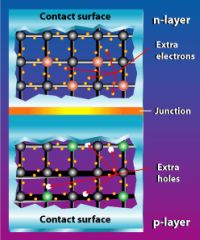|
Solar Panels
Solar panels are what come to mind for many people when they think of solar power. These panels use the principles of photovoltaic physics to convert the suns energy to electricity. How Solar Panels WorkI won’t pretend I know more than the basic, general principles behind how solar panels work. I find it pretty complex stuff.
Two different types of silicon are arranged in sheets layered together with electrical connections on each side (the "contact surface" in the diagram to the left). One side tends to give up electrons and the other tends to accept them. When sunlight strikes the silicon panel, the energy it adds knocks electrons loose that are then free to travel in a circuit to produce electrical energy. Solar cells have no moving parts, make no noise and require almost no maintenance. There are many different engineering approaches to using photovoltaic principles to produce electricity. The main point is that efficiencies are going up and price is going down.
For example, solar energy powers emergency phones and traffic signs in remote locations where the cost of wiring would be extremely high. People living a distance from the power grid find it less expensive to use solar energy than to pay to have wires strung to their home. As the technology evolves, photovoltaic will become more cost effective and its use is likely to grow. Distributed vs Central Power GenerationOne advantage of photovoltaic power is that it can be generated at its point of use.
While it is possible to have huge fields of solar cells acting much like a conventional power plant to produce power to distribute through the traditional electric grid, solar panels can also be widely dispersed.
For example, every home could produce at least part of its electricity with panels on its roof. That way, as homes are built, energy capacity automatically increases to meet demand. Aside from standard solar modules, the building material itself can generate photovoltaic power. Roof shingles with photovoltaic capacity are already on the market. These replace standard shingles on the roof. They generate solar electricity without needing separate solar panels. Downside of Solar PowerThe obvious downside of solar energy is that it only produces electricity directly when the sun shines. This means that either some form of storage is necessary or that other forms of power generation are available when the panels aren’t producing. Both approaches are used with some success. Batteries are one form of storage device. Heat can also be stored in thermal mass and used to generate electricity later. This is more common with high temperature photo concentrating systems. Another approach uses electricity generated when the sun is shining to pump water uphill. Later, that water can be run downhill through a turbine to generate electricity after dark. The sun showers the earth with huge amounts of energy every day. It only makes sense to put this clean form of energy to good use. Solar panels are an increasingly practical way to do just that. Solar Energy LinksClick here to go to the Solar Energy page Click here to go to Solar Energy Facts Click here to go to Solar Hot Water Click here to go to Passive Solar Home Heating Click here to go to Passive Solar Desigh Rules of Thumb Click here to go to Solar Power Tower Other LinksClick here to go to Alternative Energy Primer Home from Solar Panels |

 Pure silicon crystals are stable and non-reactive. Solar cells are made from silicon with impurities intentionally added. These impurities introduce some instability into the electrons of the crystals.
Pure silicon crystals are stable and non-reactive. Solar cells are made from silicon with impurities intentionally added. These impurities introduce some instability into the electrons of the crystals. Photovoltaic can’t compete with other forms of electricity on price alone as yet, but they’re already economically competitive for specialized uses.
Photovoltaic can’t compete with other forms of electricity on price alone as yet, but they’re already economically competitive for specialized uses.
